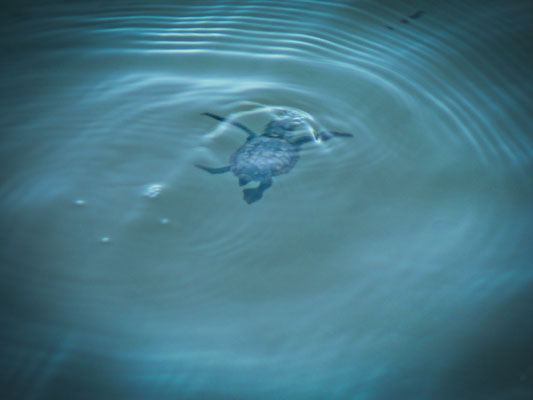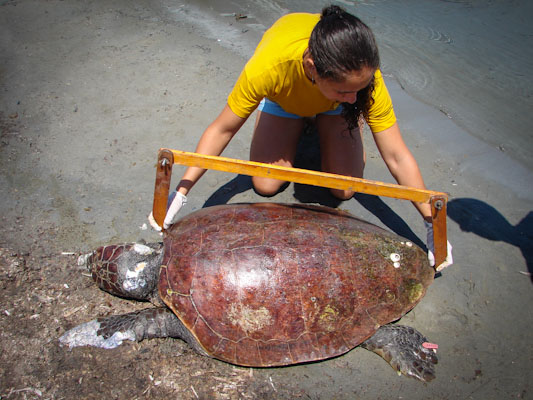Caretta Caretta Turtles
The History of the Caretta Caretta Loggerhead Turtles
Loggerhead Sea Turtles (Caretta caretta) have been on earth for 250 million years and are contemporaries of the earliest dinosaurs. The species, as with all sea turtles, is currently on the endangered species list. Every summer hundreds of Loggerhead turtles return to Zakynthos to mate and lay their eggs on the beaches in Laganas Bay.
The Caretta Caretta Loggerhead Turtles Life Cycle
Once turtles reach maturity, they return to their original nesting grounds and begin courting and mating. Males will court several females, but do not form any long-term pair bonds or parental roles in the turtles' lives. Females typically lay three to five nests throughout the summer season with eggs incubating for about two months before hatching. During this time, turtles travel further in search of food and mates. After hatching, the turtles face an arduous trek from the beach to the sea and are at risk of predators during this period. Once turtles reach adulthood, they exhibit similar basic nesting behaviors as before mating. This includes long-distance migrations and return trips back to their original nesting grounds. Therefore, turtles can often be tracked by long-term tracking studies which helps researchers protect them from predators and other threats to their survival. If you are interested in turtles, there is plenty of interesting information available about the Caretta Loggerhead turtles life cycle. You can also buy essay about turtles and understand how turtles' life cycles vary among different species. Understanding turtles and their life cycle is key to protecting them and ensuring their longevity in our environment. With a better understanding of turtles, we can work together to protect these amazing creatures from extinction. Every effort counts!
The Caretta Caretta loggerhead turtle’s mating period may last up to six weeks. It appears that the turtles court their mates. Nuzzling, biting, head movements and flipper movements are all examples of male courtship behaviour.Studies show that male Caretta Caretta loggerhead sea turtles approach the females and attempt to mount them, while females resist. The male and female Caretta Caretta sea turtles may circle each other, and if the male has competitors, the female may leave the males to struggle with each other. The winner then mounts the female and mating begins.
Over a mating season in Zante the female Caretta Caretta loggerhead turtles usually produce two or three nests. After this they produce no eggs for an average two to three years. Unlike other sea turtles, courtship and mating usually do not take place near the nesting beach, but rather along migration routes between feeding and breeding grounds. In the Mediterranean, Caretta Caretta loggerhead turtles mate from late March to early June. The nesting season peaks in June and July, but varies by nesting beach. All sea turtles have similar basic nesting behaviors. Females return to lay their eggs on or near the beach where they hatched. They haul out of the water, climb the beach, excavate a body pit, lay eggs, fill the egg chamber, fill the body pit, and finally return to sea.
Hatchlings average about 1.8 inches in length and weigh around 20 grams when they are born. After hatching, the baby Caretta Caretta turtles enter the sea and swim away from land for several days. The “post-hatchlings” then return to find a home rather close to shore. They may stay there for months, feeding on floating material and occasionally swimming to keep from getting too cold.
Eventually, they enter ocean currents farther from shore and move into the oceanic zone where they remain until they reach the juvenile stage of their life, between the ages 7 and 12.
Only one in each 1,000 baby Caretta Caretta turtles is expected to survive once they make it to the open seas. With soft shells they are eaten by fish and other sea animals. They also get caught in fishing nets and are sometimes suffocated by plastic bags floating in the ocean. Those that do survive go on to move into the neritic zone and remain there until reaching adulthood. The neritic zone is also an important area for adult foraging and inter-nesting habitats. Sea turtles live in almost every ocean of the world. Their smooth shells and paddle-like flippers help them speed through the water as fast as 24 kph. These long-distance travellers have been known to swim up to 4828 km. Although Caretta Caretta sea turtles cannot withdraw their heads into their shells, the adult Caretta Caretta loggerhead turtles are protected from predators by their shells, their large size, and of course the thick scaly skin on their heads and necks.
The Caretta Caretta Turtles in Zante
Zakynthos is the most important nesting ground for the Caretta Caretta Loggerhead turtles in all of Europe, with 80% of the Meditteranean population of turtles returning each summer to lay their eggs on the beaches in Zakynthos – particularly in the Southern coastal region. Loggerheads only return to the beach where they hatched, often thirty years previousl, so the Zakynthian population is indigenous to this spot. Due to this, if they die out the island will not be repopulated by turtles from other areas in the Mediterranean. With more and more threats from tourism effecting the turtle marine and coastal habitat in Zante, it is crucial that we work to save their home and existence.

The baby turtles swim off for around thirty years before they return to the exact same beach to lay their own eggs
The Caretta Carette Turtles and Tourism
As well as being a sea turtle nursery, Zakynthos is ofcourse also a popular holiday destination. In the summer months, at the same time that the turtles return, the island of Zante beacomes a holiday location for thousands of tourists from all over the world. With unchecked tourist development of the land, nesting areas are under immense pressure from illegal building, pollution, illegal beach furniture and traffic. Turtles are facing obstables from boats, fishermen, and beach furniture preventing them from nesting. From 11.5km of nesting beach in Laganas Bay, only 5.5km remain in a good state to attract nesting turtles.
Tourism is a critical and worsening situation in Zakynthos in terms of nesting beach destruction, this coupled with the fact that only 1 or 2 out of every 1000 hatchlings naturally survive to reach adulthood and reproduce, means that the species is teetering precariously on the edge. Yannis Vardakastanis, ESS’ founder, says that when he was a child growing up at Gerakas, he remembers the beaches black with hatchlings and females nesting during the daytime. 30 years on this is no longer seen, due to the degradation of nesting beaches, tourists on the beaches day and night, falling nest numbers and many hatchlings not even making it to the sea. Moreover each summer many adults are seriously injured or die as a direct result of tourism. More about such turtles you can read at essay writers with creating an order.
Although water sports have been banned in Laganas Bay, boating activity is unchecked. Private yachts come and go as they please with little regard for speed limits and buoys delinating the restricted Marine Park maritime zones. Turtle spotting boats are rife. Many chase the turtles, some pull them out of the water to show tourists, and cause immense distress to these animals which are only trying to rest after their exhausting nesting process. Then there are the glass bottom boats which operate in such a way as to force the turtles to dive underneath in order for paying customers to see them.

Turtles are an attraction in Zante, but are not always respected and can often be harassed by tourist boats
Although fishing is banned in Laganas Bay over the summer months, laws are not enforced and as a result turtles are still being caught in nets, ingest hooks and fishing line and become ill and die. They also swallow plastic bags which float in the water like jellyfish. These become twisted in the gut, the turtles are unable to eat, grow weak and starve to death.

Adult turtles are found dead on the beaches – there are more and more obstacles facing them now in the summer months
However, the most horrific injuries occur when speed boats collide with turtles. Injures consist of deep cuts to the carapace (shell) and internal organs, from which turtles can die a slow and agonizing death. We have not included such graphic images to avoid any distress – however, unfortunately such injuries and deaths are becoming more and more frequent.
The Future of the Caretta Caretta Turtles in Zante
Normally, when an injured turtle is found in Zante, she is flown the Rescue Hospital in Glyfada, Athens, a flight of more than 1 hour. Unfortunately, in recent years flights for the turtles are no longer available, so they have to be driven and on a noisy ferry on a 6 hour journey. This wait can be the difference between life and death. Immediate treatment is essential for the turtle to survive. Earth, Sea & Sky has teamed up with Sea Life Centre UK’s SOS Campaign to raise enough money to build a Sea Turtle Rescue and Rehabilitation Centre in Zakynthos to treat the turtles here on the island. We want to ensure that injured turtles can receive immediate medical treatment from specialist marine vets, rehabilitation and ultimately release back into the ocean, all without having to be flown to Athens. The centre is set to launch in June 2012 and we hope that many of the injured turtles found on the beaches and sea can be saved and rehavilitated here.
Earth, Sea & Sky Global also continue to run a Volunteer Programme in Gerakas, Zakynthos – offering people the chance to take a holiday in Greece while contributing to the future of the Caretta Caretta turtles at the same time. Our wonderful volunteers help to educate the public, clean the beaches, monitor the hatchlings and much much more. Please consider volunteering with us – every person helps us to make the Caretta Caretta’s future a little brighter.